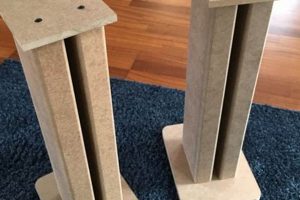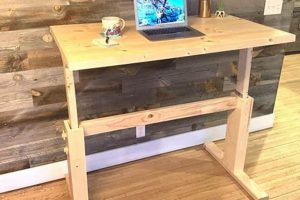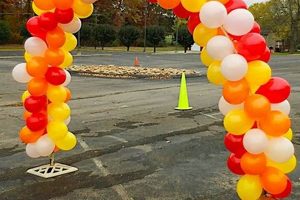The act of constructing personal shooting platforms at home, often involving readily available materials and basic tools, allows individuals to customize their practice environment. A common example involves utilizing wood, metal pipes, or even repurposed items to create a stable structure on which to affix targets.
This self-sufficiency in creating practice setups offers several advantages. It enables a shooter to tailor the stand to specific needs, such as desired height, target size compatibility, and portability. Furthermore, it can be a more economical alternative to purchasing commercially manufactured options, and provides a sense of accomplishment in creating a functional tool. Historically, the practice of creating custom shooting supports predates modern commercial offerings, born out of necessity and a desire for personalized equipment.
The subsequent sections will delve into the design considerations, material choices, and safety protocols essential for successful and responsible construction of these customized shooting solutions.
Construction Recommendations for Shooting Platforms
The following provides key considerations for the fabrication of personalized target holding structures. Attention to detail ensures both functional effectiveness and shooter safety.
Tip 1: Material Selection. Prioritize durable materials such as pressure-treated lumber or steel for extended lifespan, especially in outdoor environments. Weather resistance is paramount.
Tip 2: Stable Base Design. Employ a wide, sturdy base to prevent tipping. A-frame, H-frame, or triangular designs offer increased stability compared to simple single-post configurations.
Tip 3: Target Mounting Method. Secure the target firmly. Consider options such as clamps, staples, or backer boards, ensuring the target will not detach upon impact. Replace these elements regularly to maintain a secure structure.
Tip 4: Adjustable Height Functionality. Incorporate adjustability to accommodate various shooting stances and target sizes. Telescoping legs or adjustable brackets can provide flexibility.
Tip 5: Portability Considerations. If transport is required, design the apparatus for easy disassembly or incorporate wheels. Weight distribution should also be a primary consideration.
Tip 6: Safety Backstop Integration. If appropriate for the intended use and environment, design the framework to accommodate a backstop. This is a key element that reduces ricochet risk.
Implementing these recommendations will result in a safer and more versatile structure, ultimately enhancing the shooting practice experience. By taking the steps above will provide a safer, robust, and more flexible shooting platform.
The subsequent section will provide an in-depth consideration of safety protocols essential for responsible shooting platform utilization.
1. Material Durability
The long-term functionality and safety of self-constructed target platforms are intrinsically linked to the inherent durability of the materials employed. Component selection directly impacts the structure’s resistance to environmental degradation, repeated impact, and overall structural integrity.
- Weather Resistance
Outdoor structures are constantly exposed to moisture, temperature fluctuations, and UV radiation. Untreated wood, for example, will quickly rot and weaken, compromising stability. Pressure-treated lumber, galvanized steel, or powder-coated metals are better suited to withstand these conditions, extending the lifespan and safety of the platform.
- Impact Resistance
Target stands are subjected to repeated impacts from projectiles. Materials with higher tensile strength and resistance to deformation are necessary to prevent damage and maintain the stand’s structural integrity. Softer materials may splinter, crack, or bend over time, reducing their effectiveness and potentially creating safety hazards.
- Corrosion Resistance
Metal components are susceptible to corrosion, particularly in humid environments. Rust weakens the metal and can lead to structural failure. Selecting corrosion-resistant metals, such as stainless steel or aluminum, or applying protective coatings can significantly extend the lifespan of the platform.
- Joint Integrity
The fasteners and joining methods used to assemble the structure must also be durable. Weak joints are a common point of failure. Using high-quality screws, bolts, or welds, along with appropriate adhesives, is essential to ensure that the structure remains stable and secure under stress.
Ultimately, prioritizing robust materials results in a more reliable and safer target platform. Neglecting material durability can lead to premature failure, increasing the risk of accidents and necessitating frequent repairs or replacements. A higher initial investment in durable materials translates to long-term cost savings and improved safety.
2. Structural Stability
Structural stability is a paramount consideration in the construction of self-made target platforms. Its absence compromises the entire apparatus, leading to inaccurate practice, equipment damage, and potential physical injury.
- Base Geometry and Load Distribution
The bases geometric design dictates how weight is distributed across the structure. A wide base with evenly spaced support points enhances stability, mitigating the risk of tipping. Triangular or A-frame configurations provide inherent stability advantages over single-post designs. Improper load distribution concentrates stress, weakening joints and potentially leading to catastrophic failure under even moderate impact.
- Material Rigidity and Support Strength
The rigidity of the chosen materials directly affects the structures ability to withstand applied forces without deformation. Flexible materials like thin-gauge plastics offer inadequate support, resulting in wobble and inaccurate target presentation. Conversely, rigid materials like steel or thick lumber maintain their shape under stress, providing a stable and consistent shooting platform. The strength of individual supports (legs, cross-members) dictates the overall load-bearing capacity of the apparatus. Weak supports buckle or break under pressure, jeopardizing stability.
- Joint Integrity and Fastener Security
Joints represent critical points of potential failure in any structure. Weak or poorly executed joints compromise the entire assembly. Bolted connections, welded seams, or securely fastened screw joints ensure structural integrity. Fastener selection is crucial; undersized or low-quality fasteners shear or pull out under stress, leading to instability and potential collapse.
- Environmental Factors and Ground Conditions
Environmental factors such as wind, uneven terrain, and ground saturation directly influence stability. Designs intended for outdoor use must account for wind loads, which can exert significant force on the structure. Uneven ground conditions necessitate adjustable legs or shims to maintain a level and stable platform. Saturated ground weakens support, increasing the risk of sinking or tipping.
These facets of structural stability are inextricably linked in the context of constructing personal shooting platforms. Failure to adequately address any one of these elements can undermine the entire structure, resulting in an unstable and potentially dangerous piece of equipment. Prioritizing stable design and construction practices is crucial for safe and effective shooting practice.
3. Target Security
Target security, in the context of self-constructed shooting platforms, directly influences accuracy, safety, and the overall longevity of the equipment. Secure target mounting ensures consistent presentation, preventing movement or detachment during shooting sessions. The failure to adequately secure the target creates variability in projectile impact points, hindering skill development. Moreover, a dislodged target poses a potential hazard if it ricochets or causes instability in the stand itself. For instance, utilizing insufficient staples to secure a paper target to a wooden frame allows wind or the force of impact to tear the target, requiring frequent replacement and disrupting practice. A more robust solution, such as a securely fastened backer board, provides a stable and reliable surface for target attachment.
Several factors contribute to robust target security. The choice of attachment method, whether clamps, staples, adhesives, or a combination thereof, must be appropriate for the target material and the anticipated level of impact. The structural integrity of the stand itself plays a crucial role, as a flimsy or unstable platform transmits vibrations and increases the likelihood of target displacement. Regular inspection and maintenance of the attachment mechanisms are essential to identify and address any signs of wear or loosening. Consider a scenario where metal targets are loosely hung on DIY stands, they can swing upon impact, leading to both inaccurate shooting data and potential damage to the stand itself. Secure welding and fastening can prevent this issue.
In summary, target security represents an indispensable component of responsible shooting platform construction. It provides the foundation for accurate practice, enhances shooter safety, and protects the investment in equipment. Challenges may arise in selecting the optimal attachment method for specific target types and impact levels, but the diligent application of sound engineering principles and regular maintenance will mitigate these challenges and ensure a secure and effective shooting environment.
4. Adjustability
In the context of self-fabricated shooting platforms, adjustability significantly enhances utility and adaptability. The capacity to modify the stand’s dimensions or features directly affects its suitability for diverse shooting scenarios. A static, non-adjustable platform limits the user to a specific target size, height, and shooting stance, restricting practice versatility. For example, a fixed-height stand designed for prone shooting is unsuitable for standing or kneeling positions. The lack of adjustability, therefore, imposes limitations on skill development and target practice relevance.
Implementations of adjustability vary widely. Height adjustment, achieved through telescoping legs or threaded supports, allows shooters to adapt the target presentation to different shooting disciplines and personal preferences. Angle adjustment enables the simulation of uphill or downhill shots, adding complexity and realism to training. Adjustable target mounting brackets accommodate various target sizes and shapes. Moreover, the inclusion of adjustable features facilitates transportation and storage. A collapsible or adjustable stand occupies less space and is easier to transport than a fixed structure. One must consider the effect of these features, where, while adding complexity to the fabrication process, can provide significant benefits, increasing the practicality and value of the final product.
Ultimately, adjustability transforms a simple target holding device into a versatile training tool. Prioritizing adjustability within the design and construction process maximizes the platform’s adaptability to diverse shooting conditions. The effort invested in designing and building adjustable features results in a product that offers a greater range of training possibilities and improves the shooter’s overall skill development. An adjustable shooting target is more accessible for shooters of different heights and preferences.
5. Backstop Integration
Backstop integration represents a crucial safety element in the self-construction of shooting platforms. It mitigates risks associated with errant projectiles, ricochets, and pass-through shots. Proper integration requires careful planning and execution during the construction phase.
- Material Selection and Construction
The backstop’s material must effectively absorb or deflect projectiles. Options include tightly packed earth, sandbags, multiple layers of ballistic-rated materials (e.g., rubber, wood), or commercially available backstop systems. Construction should ensure complete coverage behind the target, extending laterally and vertically beyond the anticipated impact area. A poorly constructed backstop can exacerbate safety risks, deflecting projectiles in unpredictable directions.
- Angle and Placement
The angle of the backstop influences projectile trajectory. Angling the backstop upwards or downwards directs ricochets into the ground, reducing the risk of collateral damage. Proper placement ensures adequate distance between the target and the backstop to prevent pass-through shots. An inadequate angle or insufficient distance compromises the backstop’s ability to contain projectiles.
- Size and Coverage
The backstop’s dimensions must adequately encompass the anticipated target area. Insufficient width or height allows projectiles to escape containment, posing a safety risk to bystanders and property. Prior to construction, one must carefully assess the shooting environment and determine the appropriate backstop size to ensure comprehensive coverage.
- Maintenance and Inspection
Regular inspection and maintenance are essential for backstop effectiveness. Check for wear, damage, and projectile penetration. Replace or repair damaged sections promptly. Over time, backstop materials degrade, losing their ability to effectively absorb or deflect projectiles. Neglecting maintenance compromises safety and necessitates costly repairs.
Integrating a robust backstop into a DIY shooting platform is a critical safety measure. Diligent planning, careful construction, and consistent maintenance are essential to ensure its effectiveness. Failure to adequately address these aspects significantly increases the risk of accidents and injuries.
Frequently Asked Questions
The following addresses common inquiries regarding the design, construction, and utilization of homemade shooting platforms. Clarity on these topics promotes safety and effective target practice.
Question 1: What constitutes the most crucial safety consideration during target stand construction?
Backstop integration and projectile containment are paramount. Failure to provide adequate protection against errant shots poses a significant risk to the shooter and bystanders.
Question 2: What material selection factors influence the longevity of a self-built target platform?
Weather resistance, impact resistance, and corrosion resistance are essential considerations. Materials should withstand environmental degradation and repeated impact.
Question 3: How can the structural integrity of a shooting platform be enhanced?
Employ a wide base, utilize rigid materials, and ensure robust joint connections. Structural stability prevents tipping and ensures accurate target presentation.
Question 4: What methods are effective for securing targets to a DIY stand?
Clamps, staples, and backer boards provide secure attachment. The chosen method should be appropriate for the target material and anticipated impact levels.
Question 5: What are the advantages of incorporating adjustability into a target stand design?
Adjustability allows for accommodation of diverse shooting stances, target sizes, and training scenarios. It enhances versatility and adaptability.
Question 6: How frequently should a DIY target platform be inspected for potential hazards?
A pre-shooting inspection is mandatory. Inspect for loose joints, material damage, and compromised backstop integrity before each use.
Prioritizing these considerations fosters responsible construction practices and maximizes the safety and effectiveness of personalized shooting platforms.
The subsequent section will delve into specific design examples and construction techniques for varied target stand configurations.
Target Stands DIY
This exploration of constructing personalized target platforms underscores the need for careful planning and meticulous execution. Material selection, structural integrity, target security, adjustability, and crucially, backstop integration are not merely design considerations; they are essential elements for ensuring a safe and effective shooting environment. Neglecting any of these facets introduces unacceptable risks and compromises the fundamental purpose of skill enhancement.
Therefore, individuals undertaking the construction of target platforms bear the responsibility of prioritizing safety above all else. Thoroughly research applicable safety guidelines, employ sound engineering principles, and consistently maintain the equipment. Failure to adhere to these principles constitutes negligence and carries the potential for serious consequences. Target Stands DIY should represent a commitment to safe and responsible firearm practices.





![Build a Beautiful DIY Tiered Plant Stand [Easy Guide] The DIY Hub: Creative Crafts, Repairs & Life Hacks Build a Beautiful DIY Tiered Plant Stand [Easy Guide] | The DIY Hub: Creative Crafts, Repairs & Life Hacks](https://craftingdiycenter.com/wp-content/uploads/2025/07/th-3290-300x200.jpg)

